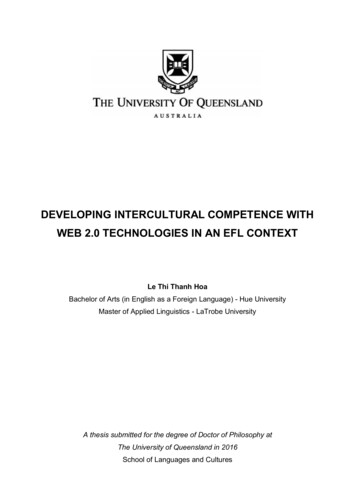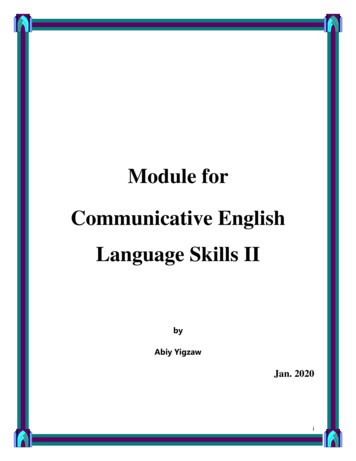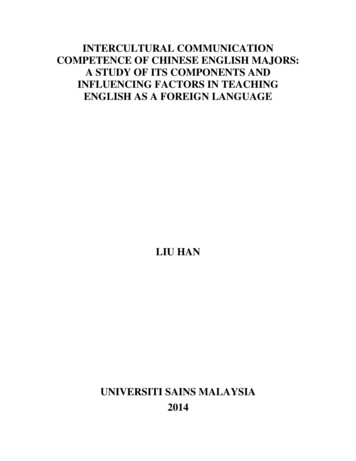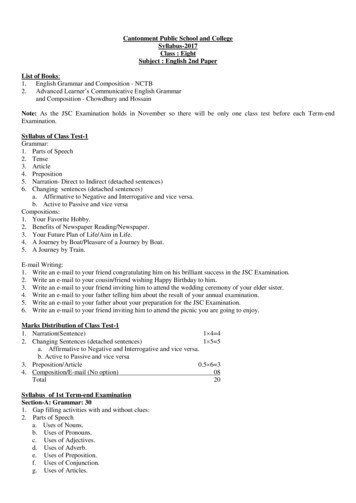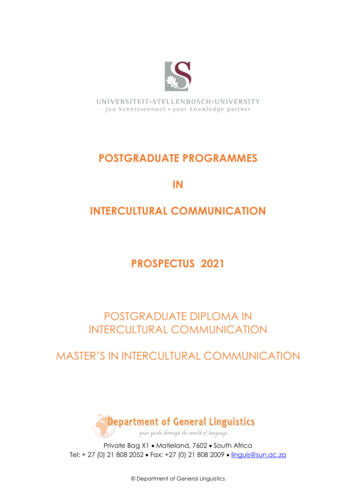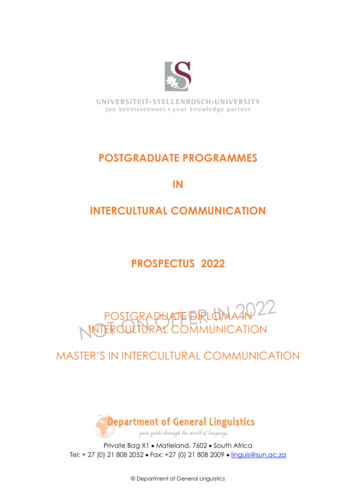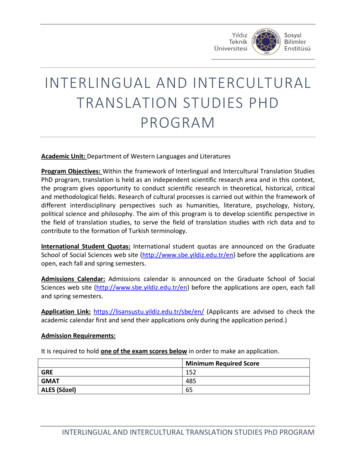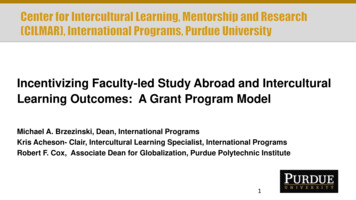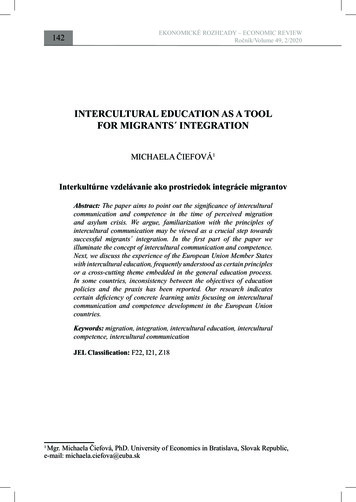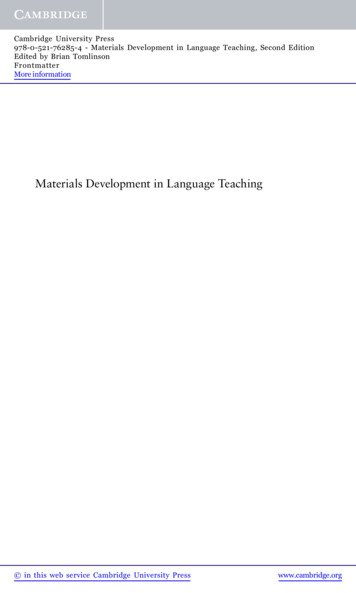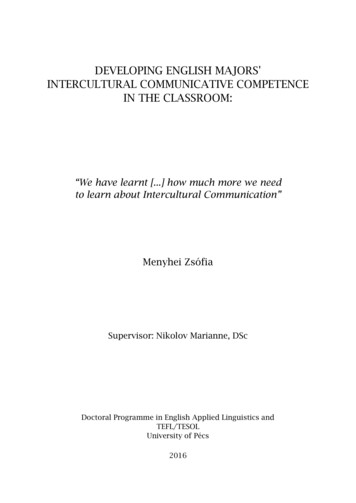
Transcription
DEVELOPING ENGLISH MAJORS'INTERCULTURAL COMMUNICATIVE COMPETENCEIN THE CLASSROOM:“We have learnt [.] how much more we needto learn about Intercultural Communication”Menyhei ZsófiaSupervisor: Nikolov Marianne, DScDoctoral Programme in English Applied Linguistics andTEFL/TESOLUniversity of Pécs2016
Table of ContentsAcknowledgementsList of abbreviations and acronymsList of figures and tablesList of AppendicesIntroduction . 1PART 1Chapter 1: Key concepts: Intercultural communication and competence . 51.1 Introduction . 51.2 Intercultural communication . 61.2.1 Cross-cultural and intercultural . 61.2.2 Different conceptualisations of culture and intercultural communication . 81.2.3 Approaches to the study of intercultural communication . 101.2.3.1 The functionalist approach . 121.2.3.2 The interpretive approach . 141.2.3.3 The critical approach . 151.3 Competence . 171.3.1 Competence from the perspective of linguistics and sociolinguistics . 181.3.2 Competence from the perspective of cognitive psychology . 191.3.3 The competence-based approach in Europe and Hungary . 221.4 Conclusion . 25Chapter 2: Intercultural communicative competence (ICC) . 262.1 Introduction . 262.2 The construct of ICC: A multiplicity of perspectives . 272.2.1 Effective and appropriate communication . 282.2.2 Comparing and contrasting ICC conceptual frameworks . 292.2.2.1 The cognitive, behavioural and affective dimension . 342.2.2.2 Differences in central concepts . 362.3 Byram’s model and the intercultural speaker . 382.3.1 The intercultural speaker . 392.3.2 The model . 402.3.2.1 The communicative element . 422.3.2.2 The intercultural element . 442.3.2.3 The critical element . 472.3.3 Critiques of Byram’s model . 482.4 Conclusion . 49
Chapter 3: ICC development and assessment . 513.1 Introduction . 513.2 The contexts of intercultural teaching and learning . 523.2.1 Compulsory education . 523.2.2 Tertiary education and professional contexts . 543.2.3 The context of the empirical studies: Hungarian tertiary education . 563.3 Approaches to ICC development. 593.3.1 The facts-oriented approach . 603.3.2 The ethnographic approach . 613.3.3 The critical approach . 633.3.4 The social constructivist classroom . 653.4 ICC assessment. 673.4.1 Indirect assessment tools . 683.4.2 Direct assessment tools . 723.4.3 Blended assessment tools . 753.5 Conclusion . 80PART 2Chapter 4: Background to the three empirical studies . 814.1 Introduction . 814.2 Setting . 824.3 Participants of the three empirical studies . 834.4 Purpose of the research and research questions . 844.5 Methods of data collection and analysis . 854.5.1 The exploratory study on three intercultural communication courses . 854.5.2 The two classroom studies on developing students’ ICC . 864.6 Issues of trustworthiness . 904.7 Role of the researcher . 914.8 Ethical considerations . 924.9 Conclusion . 93Chapter 5: Exploring three intercultural communication courses . 955.1 Introduction . 955.2 Research questions. 965.3 Method . 975.3.1 Participants. 975.3.2 Data collection methods and procedures. 975.3.3 Data analysis methods and procedures . 985.4 Findings . 995.4.1 Research question 1: Classroom practices . 1005.4.1.1 Topics . 100
5.4.1.2 Materials. 1015.4.1.3 Activities . 1025.4.1.4 Assessment . 1035.4.2 Research question 2: The teachers’ attitudes toward the courses . 1055.4.2.1 The parameters of the field of IC . 1055.4.2.2 The issue of willingness to communicate . 1065.4.3 Research question 3: The students’ attitudes toward the courses . 1085.4.3.1 Materials and authentic examples . 1085.4.3.2 Assessment . 1095.4.3.3 The issue of willingness to communicate . 1105.4.4 Research question 4: The students’ views about the topics and activities . 1115.4.4.1 Topics . 1115.4.4.2 Activities . 1135.4.5 Research question 5: How the courses have proved useful for the students . 1165.5 Conclusion . 118Chapter 6: Two classroom studies on developing students’ ICC . 1206.1 Introduction . 1216.2 Research questions. 1226.3 Method of Classroom Study 1 . 1236.3.1 Course design . 1236.3.1.1 A general description of the course. 1236.3.1.2 Considerations in designing the syllabus . 1246.3.1.3 Activities and assignments . 1286.3.2 Participants. 1336.3.3 Data collection methods and procedures. 1346.3.4 Data analysis methods and procedures . 1366.4 Findings of Classroom Study 1 . 1376.4.1 Research question 6: The social constructivist classroom . 1376.4.1.1 Classroom processes of Seminar 1 . 1386.4.1.2 What the students liked and disliked about Seminar 1 . 1426.4.1.3 The students’ views about learning in the social constructivist classroom . 1476.4.2 Research question 7: The students’ ICC development . 1506.4.3 Conclusions drawn from Classroom Study 1 . 1556.5 Method of Classroom Study 2 . 1586.5.1 Changes to the course design . 1586.5.2 Participants. 1636.5.3 Data collection methods and procedures. 1646.5.4 Data analysis methods and procedures . 1666.6 Findings of Classroom Study 2 . 167
6.6.1 Research question 6: The social constructivist classroom . 1676.6.1.1 Classroom processes of Seminar 2 . 1686.6.1.2 What the students liked and disliked about Seminar 2 . 1716.6.1.3 The students’ views about learning in the social constructivist classroom . 1766.6.2 Research question 7: The students’ ICC development . 1796.6.2.1 Differences in the students’ ICC profiles . 1806.6.2.2 Related individual differences . 1856.6.2.3 Differences in the students’ development: Three case studies . 1916.6.2.3.1 Mark . 1936.6.2.3.2 Nora. 1986.6.2.3.3 Daniel. 2026.6.3 Conclusions drawn from Classroom Study 2 . 206Final conclusions . 208Limitations and future directions . 213References . 215Appendices . 229Appendix A . 229Appendix B . 234Appendix C . 239Appendix D . 245Appendix E . 252Appendix F . 258Appendix G . 268
AcknowledgementsI am greatly indebted to the students and teachers whose voices appear in thisthesis for participating in the research.I am also incredibly grateful to my supervisor, Nikolov Marianne for all hersupport throughout these years. Her patient guidance, dedication, valuableinsights and endless supply of brilliant ideas have helped me tremendously inwriting this thesis.
List of abbreviations and acronymsAICAssessing Intercultural CompetenceAIEAutobiography of Intercultural EncountersALApplied LinguisticsBASICBehavioral Assessment Scale for Intercultural Communication EffectivenessCEFRCommon European Framework of Reference for LanguagesCLTCommunicative Language TeachingCS1Classroom Study 1CS2Classroom Study 2DMISDevelopmental Model of Intercultural SensitivityEFLEnglish as a Foreign LanguageESExploratory StudyFLTForeign Language TeachingICIntercultural CommunicationICCIntercultural Communicative CompetenceIDIIntercultural Development InventoryINCAIntercultural Competence AssessmentISIntercultural SpeakerL1First LanguageL2Second LanguageNCCNational Core CurriculumRRespondentRQResearch QuestionSStudent (in the Exploratory Study and Classroom Study 1)StStudent (in Classroom Study 2)TTeacher
List of figures and tablesFigure 1Hymes’s Communicative Competence ModelFigure 2Byram’s ICC modelTable 1Phases of the researchTable 2Three approaches to the study of Intercultural CommunicationTable 3Hofstede’s five dimensions of country-level cultural variationTable 4Dimensions and structure of knowledgeTable 5ICC conceptual frameworksTable 6A selection of objectives for Byram’s intercultural dimensionsTable 7Reviewed ICC assessment toolsTable 8Levels for Tolerance for ambiguityTable 9Sample scenario testing Tolerance for ambiguityTable 10Phases of the researchTable 11Percentage of ratings for topics in the ESTable 12Percentage of ratings for activities in the ESTable 13ICC objectives drawn on in Seminar 1 and Seminar 2Table 14Overview of the topics, in-class activities and home assignments in Seminar 1Table 15Example of classroom processes in Seminar 1Table 16Aspects of Seminar 1 mentioned by the students as ones they likedTable 17Percentage of ratings for assignments in CS1Table 18Aspects of Seminar 1 mentioned by the students as ones they dislikedTable 19Overview of the topics, in-class activities and home assignments in Seminar 2Table 20Example of classroom processes in Seminar 2Table 21Aspects of Seminar 2 mentioned by the students as ones they likedTable 22Aspects of Seminar 2 mentioned by the students as ones they dislikedTable 23Percentage of ratings for assignments in CS2Table 24Percentage of ratings for ways of learning in CS2Table 25Percentage of ratings for the ICC dimensions in students’ self-evaluationTable 26Examples of Mark’s reflections on his findings in Assignment 7Table 27Examples of Mark’s reflections on his own development in his paper for the portfolioTable 28Examples of Nora’s reflections on her own development in her paper for the portfolioTable 29Examples of Daniel’s reflections on his own development in his paper for the portfolio
List of AppendicesAppendix A Data collection instruments of the Exploratory StudyAppendix B Sample course materials in Seminar 1Appendix C Data collection instruments of Classroom Study 1Appendix D Sample coding of data in Classroom Study 1Appendix E Sample course materials in Seminar 2Appendix F Consent form; Data collection instruments of Classroom Study 2Appendix G Sample coding of data in Classroom Study 2
IntroductionThe imperative for intercultural learning is not particularly new. It was recognised some decadesago in relation to the worldwide changes encapsulated in the word globalisation. Many came torealise that due to a combination of economic, political, social and technological factors, theboundaries of the world as they knew it had changed, which prompted researchers and theoristsfrom various disciplines to engage in the study of intercultural communication. A host of studiesstarted to emerge addressing culture, cultural difference and the processes of appropriate andeffective intercultural interaction in a variety of contexts. However, in the current climate of globalinterconnectedness and rapidly shifting populations, in an era when the issue of immigration hasbecome highly politicised across the globe, the need for a critical understanding of interculturalityseems more pressing than ever before.Current trends in Applied Linguistics (AL) and Foreign Language Teaching (FLT) reflecta recognition of this need. Firstly, AL has witnessed a shift in its focus to real-world languageproblems (Grabe, 2010), which means that greater emphasis is now laid on social, cultural andpolitical aspects of language (Duff, 2010). Secondly, foreign language knowledge has come to beseen as having an intercultural dimension, as evidenced by the Common European Framework ofReference for Languages (CEFR, Council of Europe, 2001, pp. 103-105), which lists interculturalawareness and intercultural skills and know-how under the general competences to be attained bylearners. There is now an understanding that in the global era the negotiation of meaning can be anextremely complex process: learners are likely to encounter not only people with a set of beliefs,values, ideologies and behaviours very different from their own, but also multilingual-multiculturalindividuals, who may hold a variety of beliefs, values and ideologies (Kramsch, 2006). In suchsituations, being merely communicatively competent in the foreign language, as in knowing howto get one’s message across accurately and appropriately, would mean being ill-equipped forfruitful cooperation. It is also necessary to possess the means of analysing a range of social andcultural processes and to have a critical understanding of our own, as well as other cultures andsocieties (Byram, 1997), hence the concept of intercultural communicative competence (ICC).This thesis is dedicated to exploring issues related to ICC development and research. Mydecision to investigate ICC was greatly influenced by my own experiences. As a university studentI had the opportunity to spend a study-abroad year in the Netherlands, where I came to realise someof the complexities involved in intercultural interaction, and also recognised the immense1
importance of being competent in these situations. Later, as a teacher of English as a foreignlanguage I found myself in classrooms which were characterised by considerable cultural diversity,where my own as well as learners’ ICC came into play on a daily basis. I was intrigued by theconcept and welcomed the opportunity to teach intercultural communication courses at theUniversity of Pécs. It was here that I decided to delve into this subject matter and address thefollowing questions: What is ICC? How can it be developed and assessed in the classroom? Whatare the challenges involved in this endeavour? What are the challenges involved in researching thisendeavour? In this thesis I aim to provide answers to these questions.In doing so, I draw on a review of the literature, as well as the findings of three empiricalstudies I conducted at the Institute of English Studies, University of Pécs. The first, exploratorystudy enquired into the classroom practices characterising the intercultural communication coursestaught at the institute, and also investigated teachers’ and students’ opinions about these courses. Irelied on the findings gained in planning the intercultural communication seminars which I wouldlater offer at the same institute. In these seminars I resolved (1) to take a social constructivistapproach to developing English majors’ ICC, and (2) to investigate this development. Twoclassroom studies were therefore carried out with the aim of gaining a better understanding ofvarious aspects of the students’ intercultural learning in the social constructivist classroom. Thespecifics of the three research phases, such as the number of participants, the data sources andmethods of analysis, as well as the seven research questions guiding the research, are outlined inTable 1 on page 4.The thesis is divided into two parts, which include three chapters each. In Part 1 I aim toprovide a critical review of the literature. In Chapter 1, I explore two concepts integrated in ICC:intercultural communication and competence. I first survey various views of what culture andintercultural communication entails, and point to their different theoretical underpinnings andinherent assumptions. I then examine approaches to the concept of competence, starting out fromChomsky’s (1965) notions and eventually leading up to its use in current educational discourse.All of this lays the groundwork for the topic of Chapter 2: the construct of ICC. Here I discuss howthe construct
List of abbreviations and acronyms AIC Assessing Intercultural Competence AIE Autobiography of Intercultural Encounters AL Applied Linguistics
